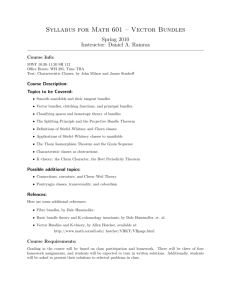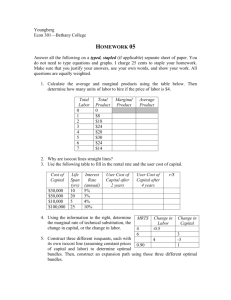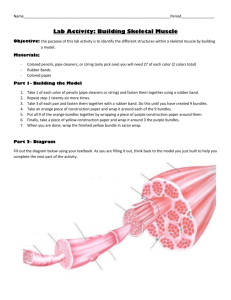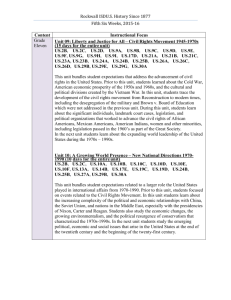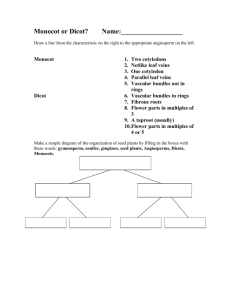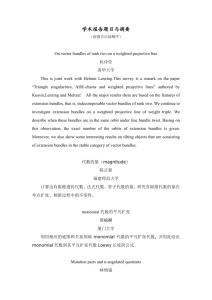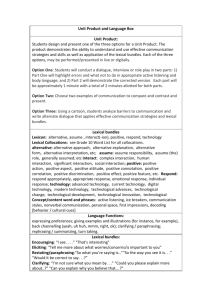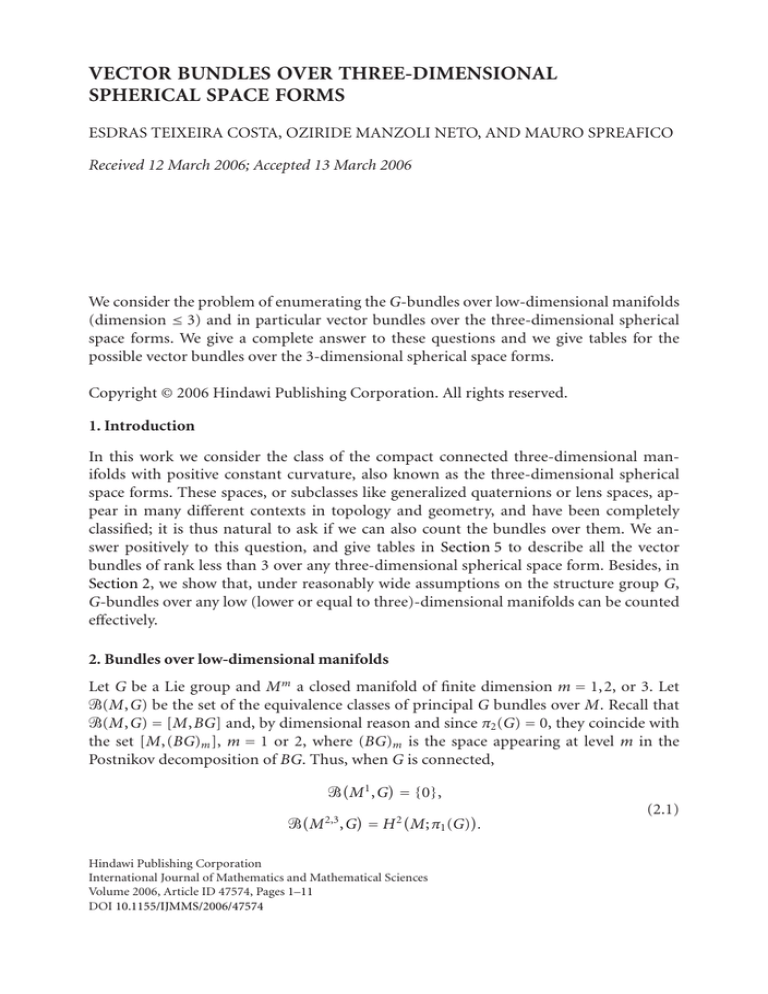
VECTOR BUNDLES OVER THREE-DIMENSIONAL
SPHERICAL SPACE FORMS
ESDRAS TEIXEIRA COSTA, OZIRIDE MANZOLI NETO, AND MAURO SPREAFICO
Received 12 March 2006; Accepted 13 March 2006
We consider the problem of enumerating the G-bundles over low-dimensional manifolds
(dimension ≤ 3) and in particular vector bundles over the three-dimensional spherical
space forms. We give a complete answer to these questions and we give tables for the
possible vector bundles over the 3-dimensional spherical space forms.
Copyright © 2006 Hindawi Publishing Corporation. All rights reserved.
1. Introduction
In this work we consider the class of the compact connected three-dimensional manifolds with positive constant curvature, also known as the three-dimensional spherical
space forms. These spaces, or subclasses like generalized quaternions or lens spaces, appear in many different contexts in topology and geometry, and have been completely
classified; it is thus natural to ask if we can also count the bundles over them. We answer positively to this question, and give tables in Section 5 to describe all the vector
bundles of rank less than 3 over any three-dimensional spherical space form. Besides, in
Section 2, we show that, under reasonably wide assumptions on the structure group G,
G-bundles over any low (lower or equal to three)-dimensional manifolds can be counted
effectively.
2. Bundles over low-dimensional manifolds
Let G be a Lie group and M m a closed manifold of finite dimension m = 1,2, or 3. Let
Ꮾ(M,G) be the set of the equivalence classes of principal G bundles over M. Recall that
Ꮾ(M,G) = [M,BG] and, by dimensional reason and since π2 (G) = 0, they coincide with
the set [M,(BG)m ], m = 1 or 2, where (BG)m is the space appearing at level m in the
Postnikov decomposition of BG. Thus, when G is connected,
Ꮾ M 1 ,G = {0},
Ꮾ M 2,3 ,G = H 2 M;π1 (G) .
Hindawi Publishing Corporation
International Journal of Mathematics and Mathematical Sciences
Volume 2006, Article ID 47574, Pages 1–11
DOI 10.1155/IJMMS/2006/47574
(2.1)
2
Vector bundles over three-dimensional spherical space forms
When G is not connected we need local coefficients. We can proceed as in [7] and
use the Larmore spectral sequence [6]. We introduce the following quite general assumption: we assume that the projection p0 : G → G/G0 to the quotient by the connected component of the identity has a continuous section s : G/G0 → G. If this is the case, then
G = G/G0 α G0 , for some homomorphism α : G/G0 → Aut(G0 ), and we can apply [7,
Proposition 1].
Proposition 2.1. The classifying space BG is the total space of a G/G0 -bundle over B(G/G0 )
with fibre BG0 and projection B p0 : BG → B(G/G0 ). Moreover, the splitting map s induces a
cross-section Bs : B(G/G0 ) → BG.
Hence, the relevant Postnikov sections are twisted Eilenberg-Mac Lane spaces, and we
obtain the exact sequence of sets
(B p0 )∗
(Bi )
M,BG0 −−−0−∗→ [M,BG] −−−−−→ M,B G/G0
−→ 0.
(2.2)
When M has dimension 1, this gives
M 1 ,BG = Hom π1 M 1 ,π0 (G) /Pπ0 (G),
(2.3)
where the action is by conjugation, namely (φ,α)(x) → φα (x) = α−1 φ(x)α, and PG =
G/ZG denotes the quotient by the center. When M has dimension 2 or 3, we need to
compute (B p0 )−∗1 (B p0 )∗ ([ f ]) for [ f ] ∈ [M,BG]0 . By surjectivity, it is enough to compute
(B p0 )−∗1 ([u]) for all [u] ∈ [M,B(G/G0 )]0 , and as before we can enumerate the elements
[u] ∈ [M,B(G/G0 )]0 by the correspondent elements φu ∈ Hom(π1 (M),π0 (G)). We can
use the Larmore spectral sequence [6] as in [7] (that has trivial differential in this case).
We obtain (B p0 )−∗1 (uφ ) = H 2 (M;π1 (G,uφ )), and hence
[M,BG]0 =
H 2 M;π1 G,uφ .
(2.4)
φ∈Hom(π1 (M),π0 (G))
Eventually, we need to get the quotient by the action of π0 (G) to get free classes. It
follows from [6, Theorem 2.2.2] that the operation + commutes with the action of π0 (G)
as follows: (uφ + b)α = uαφ + 1α∗ (b), with 1α∗ ∈ Aut(H 2 (M;π1 (G,uφ ))), and hence the quotient can be taken on the group of the homomorphisms. In summary, we have proved the
following theorem.
Theorem 2.2. Let G be a compact Lie group satisfying the above assumption and M a closed
manifold of dimension 1, 2, or 3. Then,
Ꮾ M 1 ,G = Hom π1 M 1 ,π0 (G) /Pπ0 (G),
B M 2,3 ,G =
φ̄∈Hom(π1 (M),π0 (G))/Pπ0 (G)
H 2 M;π1 G,uφ /π0 (G).
(2.5)
Esdras Teixeira Costa et al. 3
Notice that the action of π0 (G) is trivial whenever π0 (G) is abelian (in particular if G
is abelian) and BG is 2-simple.
3. Twisted cohomology of 3-dimensional spherical space forms
Let p : F → F/R = G be a presentation for a finite group G, where F and R are free on the
sets S and T, respectively. By [3] or [1] we obtain a free resolution of Z over ZG as follows.
Let A and B denote ordered sets of abstract module’s generators, one generator for each
element in the corresponding set of the group’s generators S and T, respectively, let e be
a single abstract generator, and define the homomorphisms
φ1 (a) = 1 − sa e,
φ2 (b) =
dsb ra a,
(3.1)
a∈A
where sb and ra denote the elements in the group’s generators set corresponding to the
abstract basis elements, and we recall that the group derivation is defined on the elements
of F by ds 1 = 0, ds (uv) = ds (u) + uds v, and dsi s j = δi j , for all s ∈ S. A free resolution of Z
over G is then
· · · −→ ZG[B] −−→ ZG[A] −−→ ZG[e] −→ Z −→ 0.
φ2
φ1
(3.2)
Let Γ be a finite subgroup of SO4 (R) operating freely on the three sphere S3 . The quotient spaces SΓ = S3 /Γ are three-dimensional Riemannian orientable closed manifolds
called (orthogonal) spherical space forms [10]. A first complete classification of these
manifolds was given implicitly by Hopf [5] and in more details by Seifert and Threlfall
[8]. This classification is given by the list of the possible groups Γ (see also [4]). They are
(for presentations see Section 4)
(1) the cyclic group C(n), the generalized quaternionic group Q(4n), the binary
tetrahedral group T ∗ (24), the binary octahedral group O∗ (48), and the binary
icosahedral group I ∗ (120);
(2) the semidirect products C(2n + 1) C(2k ), k ≥ 2, n ≥ 1;
(3) the semidirect products Q(8) C(3k ), k ≥ 1;
(4) the product of any of the above groups with a cyclic group of coprime order.
Since SΓ is the three-skeleton of the Eilenberg Mac Lane space K(1,Γ), and all the
groups appearing in the above list are finite and finitely presented, the ZΓ-chain complex
for the universal covering space SΓ (∼
= S3 ) is given by the resolution (3.2). This provides the
chain complex only up to level 2, but this is enough for our purpose since we can dualize
the complex to compute the first cohomology groups and eventually apply a generalized
version of the Poincaré duality, that holds here without restrictions since the manifolds
are orientable, to complete the calculations.
4. Calculations
In this section we do the necessary calculations in order to apply Theorem 2.2 for the real
vector bundles over the spherical space forms of dimension 3. Thus, M = SΓ (Γ being one
4
Vector bundles over three-dimensional spherical space forms
of the groups listed in Section 3), G = On , G0 = SOn , G/G0 = π0 (G) = Z/2, and π2 (BG) =
π1 (G) = 0, Z or Z/2, n = 1,2,3. Notice that G is abelian and BG is 2-simple in all cases
except one, when the action of π1 (BG) corresponds to a change in the local orientation
of the bundle. Actually, this case never arises, as appears from the tables in Section 5.
We proceed with the calculations as follows. Each time, we first compute Hom(π1 (SΓ ),
π0 (G)) = Hom(Ab(Γ), Z/2), that corresponds to the set of the real line bundles over SΓ .
Next, we need the cohomology of SΓ , twisted by all these line bundles if n = 2. Let u be an
element in [SΓ ,B(G/G0 )] that classifies a line bundle, and let φu in Hom(π1 (SΓ ),π0 (G)) be
the corresponding homomorphism. We need to compute H 2 (SΓ ;π1 (G,u)). When G = O2 ,
since (BG)1 = G/G0 , the sheaf π1 (G,u) with fibre π1 (G) = Z and group π0 (G) = Z/2, acting by the automorphism determined by a representation ρ : π0 (G) → Aut(π1 (G)), corresponds bijectively to (is classified by) the twisting homomorphisms φ : π1 (SΓ ) → π0 (G),
that is, we can identify (in the other cases we just need the trivial sheaf) H 2 (SΓ ;π1 (G,uφ ))
= H 2 (SΓ ; Zρφ ).
Therefore, for each Γ and each allowed representation for it, we give the explicit form of
the chain complex described in Section 3, and we compute the twisted homology groups.
We will use the following notation for the groups representations: for a subset W of the
set of the generators of Γ, let ρW : Γ → Aut(Z) denote the homomorphism determined by
ρW (W) = −1 and ρW (S\W) = 1; ρ0 will denote the trivial representation. Observe that
not all such W define a homomorphism, the relations of the presentation of Γ impose
restrictions on that. Notice also that, whenever we know a complete chain complex, we
write it down explicitly.
4.1. Cyclic groups, C(t) = (x : xt = 1). Allow representation:
Hom C(2n + 1), Z/2 = ρ0 ,
(4.1)
Hom C(2n), Z/2 = ρ0 ,ρx .
In this case we have a full periodic resolution, see [3] or [2], that gives the chain complex
0 −→ ZΓ[d] −−→ ZΓ[c] −−→ ZΓ[b] −−→ ZΓ[a] −→ 0,
d3
d2
d1
d1 (b) = (x − 1)a,
(4.2)
d2 (c) = 1 + x + x2 + · · · + xt−1 b,
d3 (d) = (x − 1)c.
The homology groups in the above representations are
Twisted homology
ρ0
ρx
H0
H1
Z
Z/t
Z/2
0
H2
0
Z/2
H3
Z
0
Esdras Teixeira Costa et al. 5
while the cohomology with global Z/2 coefficients is
Z/2-cohomology
H0
H1
H2
H3
Z/2
Z/(2,t)
Z/(2,t)
Z/2
where (n,m) denotes the gcd of n and m.
4.2. Generalized quaternionic groups, Q(4t) = (x, y : xt = y 2 , xyx = y). Allow representation:
Hom Q(8n), Z/2 = ρ0 ,ρx ,ρ y ,ρx,y ,
Hom Q(8n + 4), Z/2 = ρ0 ,ρ y ,
0 −→ ZΓ[d] −−→ ZΓ c1 ,c2 −−→ ZΓ b1 ,b2 −−→ ZΓ[a] −→ 0,
d3
d2
d1 b1 = (x − 1)a,
d1
(4.3)
d1 b2 = (y − 1)a,
d2 c1 = 1 + x + x2 + · · · + xt−1 b1 + (− y − 1)b2 ,
d2 c2 = (xy + 1)b1 + (x − 1)b2 ,
d3 (d) = (x − 1)c1 + (−xy + 1)c2 .
The homology groups in the above representations are
Twisted homology
H0
H1
H2
H3
ρ0
Z
Z/2 ⊕ Z/(2,t)
0
Z
ρx
Z/2
Z/2
Z/2
0
ρy
Z/2
Z/t
Z/2
0
ρx,y
Z/2
Z/2
Z/2
0
while the cohomology with global Z/2 coefficients is
Z/2-cohomology
H0
H1
H2
H3
Z/2
Z/2 ⊕ Z/(2,t)
Z/2 ⊕ Z/2
Z/2
6
Vector bundles over three-dimensional spherical space forms
4.3. The binary tetrahedral group, T ∗ (24) = (x, y : yxy = x2 , xyx = y 2 ).
Hom T ∗ (24), Z/2 = ρ0 ,
· · · −→ ZΓ[d] −−→ ZΓ c1 ,c2 −−→ ZΓ b1 ,b2 −−→ ZΓ[a] −→ 0,
d3
d2
d1
d1 (b2 ) = (y − 1)a,
d1 b1 = (x − 1)a,
(4.4)
d2 c1 = (y − x − 1)b1 + (1 + yx)b2 ,
d2 c2 = (1 + xy)b1 + (x − y − 1)b2 ,
d3 (d) = (x − 1)c1 + (y − 1)c2
(the resolution has been communicated by Svengrowski and Tomoda [9]),
Twisted homology
ρ0
H0
H1
H2
H3
Z
Z3
0
Z
Z/2-cohomology
H0
H1
H2
H3
Z/2
0
0
Z/2
4.4. The binary octahedral group, O∗ (48) = (x, y : xyx = yxy, xy 2 x = y 2 ).
Hom O∗ (48), Z/2 = ρ0 ,ρx,y ,
· · · −→ ZΓ[d] −−→ ZΓ c1 ,c2 −−→ ZΓ b1 ,b2 −−→ ZΓ[a] −→ 0,
d3
d2
d1 b1 = (x − 1)a,
d1
d1 b2 = (y − 1)a,
d2 c1 = (1 − y + xy)b1 + (x − 1 − yx)b2 ,
d2 c2 = 1 + xy 2 b1 + (x − 1 − y + xy)b2 ,
d3 (d) = (1 − xy)c1 + (y − 1)c2
(4.5)
Esdras Teixeira Costa et al. 7
(the resolution has been communicated by Svengrowski and Tomoda [9]),
Twisted homology
H0
H1
H2
H3
ρ0
Z
Z/2
0
Z
ρx,y
Z/2
Z/3
Z/2
0
Z/2-cohomology
H0
H1
H2
H3
Z/2
Z/2
Z/2
Z/2
4.5. The binary icosahedral group, I ∗ (120) = (x, y : xy 2 x = yxy, yx2 y = xyx).
Hom I ∗ (120), Z/2 = ρ0 ,
· · · −→ ZΓ[d] −−→ ZΓ c1 ,c2 −−→ ZΓ b1 ,b2 −−→ ZΓ[a] −→ 0,
d3
d2
d1 b1 = (x − 1)a,
d1
d1 b2 = (y − 1)a,
(4.6)
d2 c1 = 1 − y + xy 2 b1 + (−1 + x + xy − yx)b2 ,
d2 c2 = (−1 + y + yx − xy)b1 + (1 − x + yx2 )b2 ,
d3 (d) = (1 − yx)c1 + (1 − xy)c2
(the resolution has been communicated by Svengrowski and Tomoda [9]),
Twisted homology
ρ0
H0
H1
H2
H3
Z
0
0
Z
Z/2-cohomology
H0
H1
H2
H3
Z/2
0
0
Z/2
8
Vector bundles over three-dimensional spherical space forms
4.6. C(2n + 1) C(2k ) = (x, y : x2 = y 2n+1 = 1, xyx−1 = y −1 ), k ≥ 2, n ≥ 1.
k
Hom C(2n + 1) C 2k , Z/2 = ρ0 ,ρx ,
· · · −−→ ZΓ c1 ,c2 ,c3 −−→ ZΓ b1 ,b2 −−→ ZΓ[a] −→ 0,
d3
d1 b2 = (y − 1)a,
d2 c1 = 1 + x + · · · + x2 −1 b1 ,
k
d1
d1 b1 = (x − 1)a,
d2
(4.7)
d2 c2 = 1 + y + · · · + y 2n b2 ,
d2 c3 = 1 − y −1 b1 + x + y −1 b2 ,
Twisted homology
H1
H2
k
Z/2
0
Z/(2n + 1)
Z/2
H0
Z
ρ0
ρx
Z/2
H3
Z
0
Z/2-cohomology
H0
H1
Z/2
Z/2
H2
Z/2 ⊕ Z/2
H3
Z/2
4.7. Q(8) C(3k ) = (x, y,z : x2 = (xy)2 = y 2 , z3 = 1, zxz−1 = y, zyz−1 = xy), k ≥ 1.
k
Hom Q(8) C 3k , Z/2 = ρ0 ,
· · · −→ ZΓ c1 ,c2 ,c3 ,c4 ,c5 −−→ ZΓ b1 ,b2 ,b3 −−→ ZΓ[a] −→ 0,
d2
d1 b1 = (x − 1)a,
d1
d1 b2 = (y − 1)a,
d1 b3 = (z − 1)a,
d2 c1 = 1 + xy − xyxyx−1 − xyxyx−2 b1 + (x + xyx)b2 ,
d2 c2 = (1 + xy)b1 + x − xyxy −1 b2 ,
k
d2 c5 = − zyz−1 y −1 x−1 b1 + z − zyz−1 y −1 b2 + 1 − zyz−1 b3 ,
Twisted homology
H0
ρ0
H1
Z/3k
Z
d2 c3 = 1 + z + · · · + z3 −1 b3 ,
d2 c4 = (z)b1 + − zxz−1 y −1 b2 + 1 − zxz−1 b3 ,
(4.8)
H2
0
H3
Z
Z/2-cohomology
H0
H1
H2
H3
Z/2
0
0
Z/2
Esdras Teixeira Costa et al. 9
Table 5.1
Γ
Vect1 SΓ
Vect2 SΓ
1
1 + mβ, 0 ≤ m < t
1+αx
1 + αx
1
1 + mβ, 0 ≤ m < t
1
1, 1 + β1 , 1 + β2 , 1 + β1 + β2
1+αx
1 + αx , 1 + αx + β
1+α y
1 + α y + mβ, 0 ≤ m < t
1+αx +α y
1 + αx + α y , 1 + αx + α y + β
1
1, 1 + β1 , 1 + β2 , 1 + β1 + β2
1 + αy
1 + α y + mβ, 0 ≤ m < t
T ∗ (24)
1
1 + mβ, 0 ≤ m < 3
O∗ (48)
1
1, 1 + β
1 + αx + α y
1 + αx + α y + mβ, 0 ≤ m < 3
1
1
1
1 + mβ, 0 ≤ m < 2k
1 + αx
1 + αx + mβ, 0 ≤ m < 2n + 1
1
1 + mβ, 0 ≤ m < 3k
t = 2n
C(t)
t = 2n + 1
t = 2n
Q(4t)
t = 2n + 1
I ∗ (120)
C(2n + 1) C 2k
Q(8) C 3k
5. Vector bundles over 3-dimensional spherical space forms
In this section we give a complete enumeration of the real vector bundles of ranks 1,2,
and 3 over the 3-dimensional spherical space forms. The enumeration is given in Tables
5.1 and 5.2, where we use the following notation. In Table 5.1, for each group Γ, we list
in the first column the line bundles that are counted by their Stiefel-Whitney class; thus,
1 denotes the trivial bundle. Here, the αs are fixed generators of H 1 (SΓ ; Z/2)—note that
we can identify this set with Hom(Γ, Z/2). In the second column are listed, for each line
bundle with first SW class αs , the 2 bundles with the same first SW class. These 2 bundles
are counted by expressions like 1 + αs + y, where y is the obstruction class in H 2 (SΓ ; Zρs ).
10
Vector bundles over three-dimensional spherical space forms
Table 5.2
Γ
t = 2n
C(t)
t = 2n + 1
t = 2n
Q(4t)
Vect1 SΓ
Vect3 SΓ
1
1, 1 + β
1+αx
1 + αx , 1 + α x + β
1
1
1
1, 1 + β1 , 1 + β2 , 1 + β1 + β2
1+αx
1, 1 + αx , 1 + αx + β1 , 1 + αx + β2 , 1 + αx + β1 + β2
1+α y
1 + α y , 1 + α y + β1 , 1 + α y + β2 , 1 + α y + β1 + β2
1+αx + α y
1 + αx + α y , 1 + αx + α y + β1 ,
1 + αx + α y + β2 , 1 + αx + α y + β1 + β2
1
1, 1 + β1 , 1 + β2 , 1 + β1 + β2
1 + αy
1 + α y , 1 + α y + β1 , 1 + α y + β2 , 1 + α y + β1 + β2
T ∗ (24)
1
1
O∗ (48)
1
1, 1 + β
1 + αx + α y
1 + αx + α y , 1 + α x + α y + β
1
1
1
1, 1 + β1 , 1 + β2 , 1 + β1 + β2
1 + αx
1 + αx , 1 + αx + β1 , 1 + αx + β2 , 1 + αx + β1 + β2
1
1
t = 2n + 1
I ∗ (120)
C(2n + 1) C 2k
Q(8) C 3k
Here, the βi are fixed generators of H 2 (SΓ ; Zρs ). In Table 5.2 appear the real vector bundles
of rank 3 with the same notation (but the βi are generators of H 2 (SΓ ; Z/2)).
References
[1] K. S. Brown, Cohomology of Groups, Graduate Texts in Mathematics, vol. 87, Springer, New York,
1982.
[2] H. Cartan and S. Eilenberg, Homological Algebra, Princeton University Press, New Jersey, 1956.
[3] K. W. Gruenberg, Resolutions by relations, Journal of the London Mathematical Society 35
(1960), 481–494.
[4] I. Hambleton and R. Lee, A four-dimensional approach to the spherical space form problem, unpublished.
Esdras Teixeira Costa et al.
11
[5] H. Hopf, Zum Clifford-Kleinschen Raumproblem, Mathematische Annalen 95 (1925), no. 1, 313–
339.
[6] L. L. Larmore, Twisted cohomology and enumeration of vector bundles, Pacific Journal of Mathematics 30 (1969), 437–457.
[7] A. Minatta, R. Piccinini, and M. Spreafico, A note about the isotropy groups of 2-plane bundles
over closed surfaces, Collectanea Mathematica 54 (2003), no. 3, 283–291.
[8] H. Seifert and W. Threlfall, A Textbook of Topology, Pure and Applied Mathematics, vol. 89,
Academic Press, New York, 1980.
[9] P. Svengrowski and S. Tomoda, private communication.
[10] J. A. Wolf, Spaces of Constant Curvature, McGraw-Hill, New York, 1967.
Esdras Teixeira Costa: ICMC-USP, 13560-970 São Carlos, Brazil
E-mail address: sdrs@icmc.usp.br
Oziride Manzoli Neto: ICMC-USP, 13560-970 São Carlos, Brazil
E-mail address: ozimneto@icmc.usp.br
Mauro Spreafico: ICMC-USP, 13560-970 São Carlos, Brazil
E-mail address: mauros@icmc.usp.br


